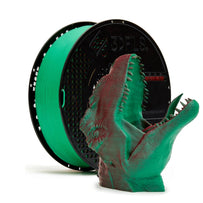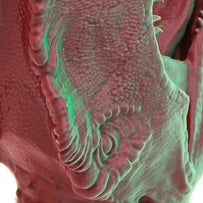PLA 1.75mm filament for 3D printer
What is PLA filament?
PLA (polylactic acid) filament is a biodegradable bioplastic derived from renewable resources such as corn and sugarcane. It is one of the most popular materials for 3D printing due to its ease of use, versatility, and low environmental impact.
Properties of PLA
PLA stands out for its unique properties that make it the perfect material for a large number of applications:
- Easy to use:It does not require a heated bed and prints at relatively low temperatures, reducing printing costs and complexity.
- Versatile:It can be printed on a wide range of 3D printers. You don't need a specialized 3D printer to use it.
- Biodegradable and non-toxic:It is a material that does not come from petroleum, so it is safe for the environment and human health.
- Low shrinkage and warping:Unlike other materials, PLA exhibits very little shrinkage and warping upon cooling, resulting in more precise, warp-free parts. This is especially useful for long print runs.
Origin and sustainability of PLA:
PLA is produced from renewable resources, making it a sustainable alternative to traditional petroleum-derived filaments. It's also biodegradable and compostable, meaning it breaks down naturally over time without leaving harmful residues.
PLA is biodegradable and compostable under industrial conditions. It breaks down into water and carbon dioxide, making it an environmentally friendly alternative to traditional filaments.
Differences between PLA and other filaments (ABS, PETG, TPU):
- ABS:ABS is a heat and abrasion resistant material, but it is less biodegradable than PLA and requires a heated bed for printing.
- PETG:PETG is water and chemical resistant, but is stiffer and less flexible than PLA.
- TPU:TPU is a flexible and abrasion-resistant material, but it is more difficult to print than PLA and requires specific printer settings.
PLA filament applications
- Prototyping
- Printing functional objects
- Art and design
Advantages of PLA filament
- Easy to use
- Biodegradable and non-toxic
- Versatile
- Wide range of colors
Disadvantages of PLA filament
- Less resistant than other materials
- Less flexible
Printing recommendations for PLA filament
- Uses a 0.4mm or 0.6mm nozzle.
- Prints at a speed of 40-100 mm/s.
- Set the printing temperature between 180-210 °C.
- A heated bed is not required, but a temperature of 50-60°C is recommended to improve adhesion.
- Uses a 2-4mm retraction setting.
Properties of PLA filament
- Density:1.24 g/cm³
- Printing temperature:180-210 °C
- Heated bed temperature:Not necessary (recommended 50-60 °C)
- Retraction:2-4 mm
- Print speed:40-100 mm/s
- Modulus of elasticity:3.5 GPa
- Tensile strength:60-70 MPa
- Flexural strength:80-90 MPa
- Elongation at break:3-5%
- Melting point:150-160 °C
Frequently Asked Questions About PLA Filament
What are PLA filaments?
PLA filaments are a type of 3D printer filament made from polylactic acid (PLA). They are created from renewable, starch-rich raw materials such as potatoes, corn, beets, and cassava. Because they are made from organic materials, they are biodegradable through composting.
Is PLA or ABS better?
PLA is the most versatile 3D printer filament available, suitable for a wide range of applications. ABS is a harder material and easier to post-process, but its difficulty in printing makes it less suitable for general use. If you're looking for the printing properties of ABS but with greater ease of printing, we recommend trying our PLA filament.ASA filament.
Is PLA or PETG better?
Both materials are very easy to work with and are both recommended for most general 3D printing applications. The advantages ofPETG filamentCompared to PLA, it has greater mechanical and chemical resistance, as well as its slight flexibility, which makes it more resistant to impacts.
How is PLA made?
PLA is a plastic produced from starch-rich plant-based raw materials such as corn or beetroot. This starch is fermented until it becomes lactic acid. Various techniques are used to polymerize the lactic acid into polylactic acid. Once PLA is obtained, it can be processed using various techniques such as injection molding, blow molding, or extrusion. At 3DFILS, we extrude PLA into filament for 3D printers.






